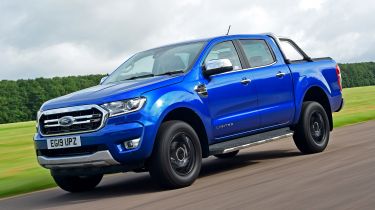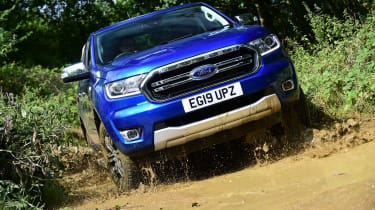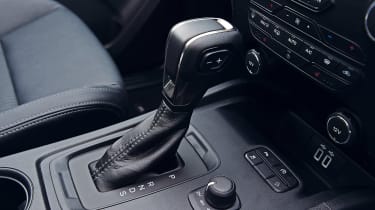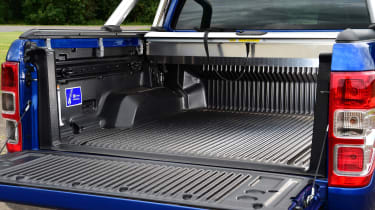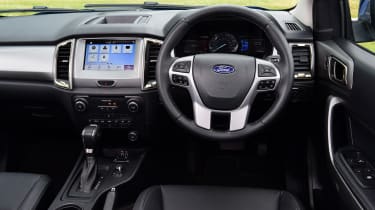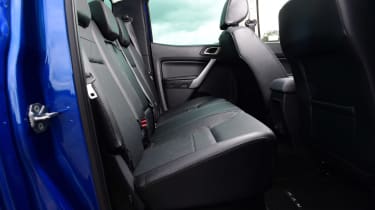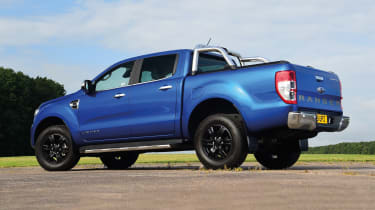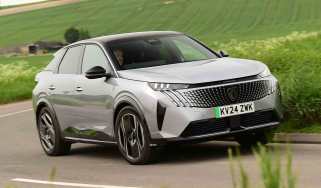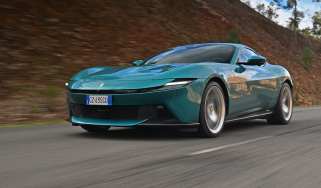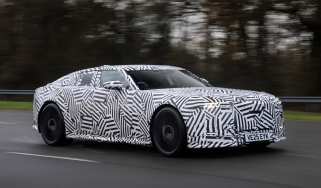Ford Ranger pick-up (2011-2022) review
The award-winning Ranger pick-up is great for work and play, but rivals may be cheaper to run
The Ford Ranger was voted Pick-up of the Year in our 2019, 2020, 2021 and 2022 New Car Awards, and it's also the UK's best seller. That's partly because Ford has a huge dealer network (the Ranger is sold via Ford's Transit Centres), while the Ranger itself is a chunky-looking pick-up that's packed with plenty of kit in top-spec variants. The double cab version is a great choice for business users wanting a work vehicle that offers family-friendly versatility when they've clocked off.
About the Ford Ranger
The Ford Ranger is the biggest selling pick-up in the UK and for good reason, combining myriad options for work and leisure-focused owners with a wide range of cabs, power outputs and specifications to suit just about any task.
Business and fleet operators who can’t afford to be off the road have the added reassurance of an extensive dealer network for maintenance and support, while owner-drivers with family and leisure commitments can choose a workhorse with more than enough style and spec to make the Ranger a viable SUV alternative at weekends.
There's a broad choice of Ranger models, but the closest competitor is probably the Toyota Hilux, while with an ever-decreasing pool of rivals, other utilitarian options include the Isuzu D-Max and SsangYong Musso.
Used - available now

2018 Volkswagen
Polo
39,500 milesManualPetrol1.2L
Cash £9,350
2020 Mercedes
E-Class
74,838 milesAutomaticPetrol2.0L
Cash £15,050
2018 MINI
Clubman
59,999 milesManualDiesel2.0L
Cash £8,150
2020 BMW
4 Series Gran Coupe
46,500 milesAutomaticDiesel3.0L
Cash £18,850Regular Cab, Super Cab and Double Cab variants form the basis of the Ranger model line-up, with the former offering the longest load bed and - with only two seats - limited opportunity for use outside work. The Super Cab is extended with a single rear-hinged side door and occasional rear seats, but it’s the Double Cab with four regular doors and a full five-seater cabin that has the broadest appeal.
There are five model grades across the Double Cab line up, starting with the entry-level XL, and rising through XLT, Wolftrack, Limited, Wildtrak, Stormtrack and Raptor variants. The top-of-the-range MS-RT Limited Edition is based on the Wildtrack model, with additional kit such as 20-inch alloy wheels, gloss black trim, wider front wings and upgraded upholstery.
The Regular Cab only comes in XL trim, but you can get the Super Cab in XLT and Limited trim too. The Wildtrak is loaded with luxury kit, while the Raptor is a full-fat, bells-and-whistles ‘statement spec’ with added performance and desert racer-inspired upgrades to the body and suspension. Raptor tweaks include a 210bhp version of the Ranger’s 2.0-litre EcoBoost diesel engine, a 10-speed automatic transmission, aggressive exterior styling and suspension tuned for a more involving drive. Wildtrak and Raptor specs are available on Double Cab versions only.
The Ranger Thunder is no longer offered on the price list, but new special editions have been introduced: the Stormtrak is based on the top-spec Wildtrak trim and includes exclusive colours and kit, while the Wolftrak is a mid-spec model orientated more towards rugged, off-road use.
If you're looking at a Ranger as an alternative to an SUV, then the Limited and Wildtrak trims have all the kit you'd ever need. The Ranger lifts many of its goodies from the passenger car range, so you get Ford's SYNC3 voice control and infotainment system, dual-zone climate control, electric heated door mirrors, rear parking sensors, heated leather seats and alloy wheels.
Power for the range comes from the 2.0-litre EcoBlue diesel unit with 128bhp, 168bhp or 210bhp. All Double Cab models, with the exception of the Raptor, get a six-speed manual gearbox with stop-start and selectable four-wheel drive as standard, while a ten-speed auto transmission is available, depending on engine/trim choice.
Of course the main benefit of the Ranger, and any pick-up - especially the more expensive versions - is that they currently qualify for a flat-rate of Benefit-In-Kind tax rate for business users. These models must have a one-tonne payload to qualify, and if they do, then they are classed as a light commercial vehicle, which means a flat rate of tax is paid that's a lot less than it would be for a similarly priced or specced SUV. If you can justify running a truck as a business vehicle, then the Ford Ranger is a great choice in terms of looks and kit.
MPG, CO2 and Running Costs
The Ford Ranger has never been the most efficient pick-up, but improvements have been made to the current model that boost fuel economy by up to 17%. Ford added auto Start-Stop to the manual model (not the auto) and electric power assisted steering, while a choice of final drive ratios supplement the changes made to the Ranger’s engines.
The Ranger Raptor gets a 210bhp version of the 2.0 EcoBlue diesel which, along with a healthy 500Nm of torque, gives the top-of-the-range pick-up a 0-62mph time of 10.0 seconds. That's not blindingly quick, but means it feels sprightly. In addition, the Ranger Raptor has a 10-speed auto similar to that seen in the Mustang and updated Transit.
The Ranger’s best combined fuel economy of 40.9mpg comes from the 2.0 EcoBlue 130PS and 170PS manual versions in Regular or Super Cab form. These models give you CO2 emissions of upto 188g/km.
If you are looking for the most economical Ranger to tow with, you will need a 2.0 EcoBlue model in Regular Cab form with the 3.55 final drive ratio, giving you CO2 emissions of 179g/km.
Whichever Ranger you choose, you'll find economy is slightly shy of more frugal models like the Nissan Navara and Mitsubishi L200. In comparison, the Ranger Raptor has claimed economy of 31.7mpg, which is reasonable considering its more powerful engine. All Rangers come with a three-year/60,000-mile warranty, which is nothing special in this day and age. That said, there is a 12-year anti-perforation warranty and a year of Ford Assistance breakdown cover thrown in.
The Ford Ranger’s insurance groups range roughly from 37E for the basic two-wheel-drive Regular Cab in XL form to 42E for the largest-engined, automatic Double Cab version in Wildtrak spec (all Ranger models and similar pickups are rated on the 30-group LCV scale that starts at 21). The higher-specification Raptor sits in group 39E.
Load Space and Practicality
The Ranger offers a model for every application. The Regular Cab is a traditional two-seater pick-up with the biggest carrying capacities in the range. It’ll take a 1,252kg gross payload and has a maximum load length of 2,317mm.
Step up to the Super Cab and you gain a pair of small rear seats, but these are more likely to be used as secure storage space for tools or materials than for people. The payload drops to between 1,142 and 1,197kg here, depending on the model, and the load length is 1,847mm.
The Double Cab Rangers will be the big sellers, offering a 1,549mm load length with payloads varying between 1,070kg and 1,199kg. If you run out of room there’s the potential to tow a braked trailer of up to 3,500kg – but remember that choosing the lesser 3.15 final drive ratio blunts that towing potential significantly to 1,800kg.
You might want to bear in mind that the Ranger Raptor’s off-road performance-orientated modifications actually hamper its practicality. So much so, in fact, that it isn’t actually classed as a light commercial vehicle and doesn’t qualify for the Benefit-In-Kind tax advantage that have made pick-up trucks so appealing to many buyers.
The Raptor’s heavy-duty chassis modifications have raised its gross weight to the extent that its maximum payload has been reduced to just 620kg, which is some 400kg below the 1040kg threshold required for LCV classification. Its maximum braked towing limit is also reduced to just 2,500kg, a full 1,000kg less than the most capable regular Ranger Double Cabs.
As is the norm in the pick-up sector, Ford offers a huge array of accessories that let Ranger customers adapt their trucks to the ways they’ll be using them. Flick through the brochure and you’ll find everything from liners to protect the steel load bed, to full-on hard-top covers that effectively turn your Ranger Double Cab into an SUV. There’s also the C-channel cargo management system that’s fitted to higher spec models, a bike carrier and, of course, a manufacturer fitted tow bar.
Reliability and Safety
The Ford Ranger has always been near to the top of the pick-up class in terms of safety. This model achieved a full five-star Euro NCAP rating when originally tested it in 2012, and now the facelift has added an arsenal of electronic driver aids to improve matters further.
All Rangers get driver, passenger, thorax and driver’s knee airbags plus a collapsible steering column and an advanced ESC stability control system. This includes Hill Start Assist, Hill Descent Control, Load Adaptive Control, Roll-over Mitigation and Trailer Sway Control so the truck is fully tooled-up in terms of technology to keep it on the straight and narrow.
Beyond this, the Driver’s Assistance Pack (which costs around £1,350) adds advanced technologies like Adaptive Cruise Control, Lane Keeping Aid, Auto High Beam headlights, Traffic Sign Recognition and Collision Mitigation.
While there have been a few reports of engine-starting problems and of driveshaft joints failing, there have been few reported issues with the Ranger’s long-term reliability. With Ford having more dealers than any other manufacturer, you're never far from a franchised outlet for service and spares if required, although you might not necessarily get a decent level of customer service if our Driver Power survey is to be believed. It finished 25th out of 29 manufacturers in our 2021 rundown. However, that score is for car retailers, rather than Ford's Transit Centres, where the Ranger is sold.
Driving and Performance
The Ranger is a decent bet from a driver’s perspective. It bounces around a little, but the electric power steering is particularly good for a pick-up in terms of its weight and responsiveness. This is all relative, of course, and anyone jumping from a large SUV into the Ranger is going to notice the choppy feel on even moderate surfaces.
The 2.0-litre EcoBlue unit offers up to 210bhp and, in auto guise, will do the 0-62mph sprint in 9.0 seconds, though it's the slightly slower manual (10.1s) that's expected to account for 70% of sales. It makes a fair degree of noise when first started up, but once warmed and up to temperature is much more agreeable.
The Ford Ranger has the full package as far as off-road equipment is concerned, and it all adds up to make for good all-terrain performance. The electronically-controlled 4x4 transmission fitted to most models allows you to shift between two and four-wheel-drive modes on the move via a small dial on the centre console. There’s also a low range 4x4 mode that’ll be useful if you plan on testing the Ranger’s 28-degree approach angle or class-leading 800mm wading depth.
With almost 30cm of ground clearance, Hill Descent Control and Hill-Start Assist the Ranger is always going to be a capable in the rough stuff. The optional Off-road Pack, however, adds a locking rear differential as well as extra protection for the underside to make it a great choice for buyers who’ll be taking their truck off-road on a frequent basis.
The Ranger Raptor is designed to be an even more capable off-roader. It gets coil spring rear suspension to help it soak up bumps better, as opposed to carrying heavy loads, and Ford is plugging the new model as an off-road focused performance machine. That said, the quality of its upgraded shock absorbers is such that it rides impressively well on the road, with a surprising degree of comfort and compliance compared with the regular Ranger models.
Cab and Interior
The Ford Ranger’s interior is relatively upmarket by pick-up standards, you get tough plastics and plenty of storage, but there’s Ford passenger car switchgear to raise the tone, and higher spec variants pile on lots of technology features.
The instrument cluster features digital colour displays either side of the main analogue dial, presenting lots of useful information, However, some of the readouts are quite small for viewing at a glance.
The same goes for some of the buttons, which despite being pleasing on the eye, are a bit fiddly to use. There’s a decent-sized glovebox, a wide door pocket in each of the doors plus a big bin under the central armrest – although the lid has a horrible tinny quality.
Ford’s SYNC3 infotainment system features an eight-inch screen. It has a bright interface that’s easy to see while on the move, especially with that big screen, and the standard Android Auto and Apple CarPlay functionality is a big plus.
Steering wheel controls and a standard six-speaker stereo are a match for its rivals, plus there’s a reversing camera on Limited models. There are USB and Aux connections for your music, too. Voice control is standard on the system as well; this lets you control various functions without distraction.
In terms of cabin space, the Ranger also does reasonably well, although it isn’t quite as roomy in the back as the Nissan Navara. The seats are set quite high so there’s no need to bunch your knees up in the rear and there’s just about room for a six-foot adult to sit behind a similarly-sized driver – although both leg and head room are tight.
In the back of higher spec models you get a couple of cup holders in the fold-down armrest and seat back pockets for extra storage, but climbing out over the Ranger’s wide side steps can be tricky.
The Ranger’s specification varies widely according to which trim level you choose. At base XL level you get 16-inch steel wheels but also useful features like Ford’s Easy-Fuel refuelling system, air conditioning, heated electric mirrors and a DAB radio.
The XLT grade adds 16-inch alloy wheels plus more creature comforts including cruise control, auto headlights and rain-sensing wipers. Things really take a step upmarket with the Limited model where you get leather trim and Ford’s SYNC3 voice control and touchscreen tech takes the place of the SYNC control system on the XLT. The bigger screen and clear menu system are infinitely preferable.
The Ranger Wildtrak features 18-inch wheels and Titanium-effect exterior trim. At this level buyers get the whole nine yards, including Wildtrack logos festooned all over the shop, satellite navigation and coloured ambient lighting for the interior.
Van dimensions
| Body style | Height | Width | Length |
| Single cab 4x4 | 1,800mm | 1,977mm | 5,282mm |
| Super cab 4x4 | 1,804mm | 1,977mm | 5,282mm |
| Double cab 4x4 | 1,815mm | 1,977mm | 5,282mm |
Load area dimensions
| Body style | Depth | Width | Length |
| Single cab 4x4 | 511mm | 1,560mm | 2,317mm |
| Super cab 4x4 | 511mm | 1,560mm | 1,847mm |
| Double cab 4x4 | 511mm | 1,560mm | 1,613mm |

